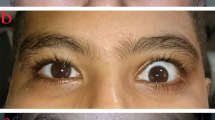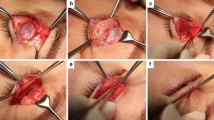Abstract
Background
For moderate ptosis associated with fair levator function (LF), the levator resection is the most commonly used procedure. However, the levator resection technique still has some disadvantages, such as residual lagophthalmos (RL), undercorrection, conjunctival prolapse, and eyelid contour abnormality. To solve the above problems, our team have made modifications to the levator resection technique in three aspects: releasing the levator muscle sufficiently, preserving the supporting structure of the conjunctiva, and placing multiple suture sites.
Methods
Fifty-seven patients (81 eyes) underwent the modified levator resection technique and were enrolled in the study. Preoperative data collected included age, sex, margin reflex distance 1 (MRD1), and LF. Postoperative data collected included MRD1, RL, patient satisfaction, complications, and length of follow-up.
Results
Mean MRD1 significantly increased from 1.45 ± 0.65 mm preoperatively to 3.57 ± 0.51 mm postoperatively. Mean LF significantly increased from 6.49 ± 1.12 mm preoperatively to 9.48 ± 1.39 mm postoperatively. Successful correction was obtained in 77 eyes (95.1%). Mean RL was 1.09 ± 0.57 and 72 eyes (88.9%) showed excellent or good eyelid closure function. Fifty-four patients (94.7%) were completely satisfied with the final result. Complications such as hematoma, infection, conjunctival prolapse, suture exposure, corneal abrasion, and keratitis were not found in any cases during follow-up.
Conclusion
This modified levator resection technique introduced in this study is effective in correcting moderate congenital blepharoptosis, while minimizing RL, undercorrection, conjunctival prolapse, eyelid contour abnormality by releasing the levator muscle sufficiently, preserving the supporting structure of the conjunctiva, and placing multiple suture sites.
Level of Evidence IV
This journal requires that authors 42 assign a level of evidence to each article. For a full 43 description of these Evidence-Based Medicine ratings, 44 please refer to the Table of Contents or the online 45 Instructions to Authors www.springer.com/00266.






Similar content being viewed by others
References
Finsterer J (2003) Ptosis: causes, presentation, and management. Aesthet Plast Surg 27(3):193–204
Emsen IM (2008) A new ptosis correction technique: a modification of levator aponeurosis advancement. J Craniofac Surg 19(3):669–674
Martin TJ, Yeatts RP (2000) Abnormalities of eyelid position and function. Semin Neurol 20(1):31–42
Allard FD, Durairaj VD (2010) Current techniques in surgical correction of congenital ptosis. Middle East Afr J Ophthalmol 17(2):129–133
Hao DY, Cang ZQ, Cui JB, Fan X, Ding JK, Wei SM et al (2022) Simultaneous double eyelid blepharoplasty and blepharoptosis correction with levator aponeurosis plication technique: clinical experience of 108 cases. Ann Plast Surg 88(6):606–611
Putterman AM, Urist MJ (1975) Müller muscle-conjunctiva resection: Technique for treatment of blepharoptosis. Arch Ophthalmol 93(8):619–623
Liu MT, Totonchi A, Katira K, Daggett J, Guyuron B (2012) Outcomes of mild to moderate upper eyelid ptosis correction using Müller’s muscle-conjunctival resection. Plast Reconstr Surg 130(6):799e–809e
Zhu X, Ma Y, Woo DM, Lin Y, Chen B, Liu J et al (2021) Improved eyelid muscle tension balance with refined frontalis muscle flap suspension in the treatment of severe ptosis. Ophthalmic Plast Reconstr Surg 37(6):534–540
Huang SH, Lee CC, Lai HT, Takahashi H, Wang YC, Lai CS (2021) The Function-preserving frontalis orbicularis oculi muscle flap for the correction of severe blepharoptosis with poor levator function. Aesthet Surg J 41(6):NP260–NP266
Liu HP, Shao Y, Li B, Yu X, Zhang D (2015) Frontalis muscle transfer technique for correction of severe congenital blepharoptosis in Chinese patients: an analysis of surgical outcomes related to frontalis muscle function. J Plast Reconstr Aesthet Surg 68(12):1667–1674
Carroll RP (1980) Preventable problems following the Fasanella-Servat procedure. Ophthalmic Surg 11(1):44–51
Kumar S, Kamal S, Kohli V (2010) Levator plication versus resection in congenital ptosis–a prospective comparative study. Orbit 29(1):29–34
Berlin AJ, Vestal KP (1989) Levator aponeurosis surgery: a retrospective review. Ophthalmology 96(7):1033–1036
Al-Faky YH, El-Eneen MAA, Selim KM, Ali HA (2020) A Modified levator resection to improve postoperative lagophthalmos and eyelid lag. Ophthalmic Plast Reconstr Surg 36(1):38–44
Zuo L, Wang XX, Huang XY, Zhang JL, Du YY (2017) A modified levator resection technique involving retention of the levator palpebrae superioris muscle suspension system for treatment of congenital ptosis. Aesthetic Plast Surg 41(4):856–862
Zigiotti GL, Delia G, Grenga P, Pichi F, Rechichi M, Jaroudi MO et al (2016) Elevator muscle anterior resection: a new technique for blepharoptosis. J Craniofac Surg 27(1):201–203
Dortzbach RK (1994) Ophthalmic plastic surgery: prevention and management of complications. Raven Press, New York, pp 65–90
Ahmad SM, Della Rocca RC (2007) Blepharoptosis: evaluation, techniques, and complications. Facial Plast Surg 23(3):203–215
Kakizaki H, Takahashi Y, Nakano T, Ikeda H, Selva D, Leibovitch I (2011) Whitnall ligament anatomy revisited. Clin Exp Ophthalmol 39(2):152–155
Parsa FD, Wolff DR, Parsa NN, Elahi E (2001) Upper eyelid ptosis repair after cataract extraction and the importance of Hering’s test. Plast Reconstr Surg 108(6):1527–1536
Zoumalan CI, Lisman RD (2010) Evaluation and management of unilateral ptosis and avoiding contralateral ptosis. Aesthet Surg J 30(3):320–328
Lukas JR, Priglinger S, Denk M, Mayr R (1996) Two fibromuscular transverse ligaments related to the levator palpebrae superioris: Whitnall’s ligament and an intermuscular transverse ligament. Anat Rec 246(3):415–422
Zhuang W, Fang S, Fan H, Zhu W, Chen Y, Tang W et al (2019) Anatomical study of the extraocular check ligament system. J Plast Reconstr Aesthet Surg 72(12):2017–2026
Holmström H, Bernström-Lundberg C, Oldfors A (2002) Anatomical study of the structures at the roof of the orbit with special reference to the check ligament of the superior fornix. Scand J Plast Reconstr Surg Hand Surg 36(3):157–159
Hwang K, Shin YH, Kim DJ (2008) Conjoint fascial sheath of the levator and superior rectus attached to the conjunctival fornix. J Craniofac Surg 19(1):241–245
Jordan DR, Anderson RL (1990) The aponeurotic approach to congenital ptosis. Ophthalmic Surg 21(4):237–244
Cruz AAV, Akaishi PMS, Mendonça AKTS, Bernadini F, Devoto M, Garcia DM (2014) Supramaximal levator resection for unilateral congenital ptosis: cosmetic and functional results. Ophthalmic Plast Reconstr Surg 30(5):366–371
Hickson-Curran S, Brennan NA, Igarashi Y, Young G (2014) Comparative evaluation of Asian and white ocular topography. Optom Vis Sci 91(12):1396–1405
Zhou J, Chen W, Qi Z, Jin X (2019) Minimally invasive conjoint fascial sheath suspension for blepharoptosis correction. Aesthetic Plast Surg 43(4):956–963
Xing Y, Wang X, Cao Y, Ding X, Lin L, Li J et al (2019) Modified combined fascia sheath and levator muscle complex suspension with Müller muscle preservation on treating severe congenital ptosis. Ann Plast Surg 82(1):39–45
Chu CC, Pratt L, Zhang L, Hsu A, Chu A (1993) A comparison of a new polypropylene suture with prolene. J Appl Biomater 4(2):169–181
Kyrillos R, Harissi-Dagher M (2011) Prolene monofilament suture in Boston Keratoprosthesis surgery. Digit J Ophthalmol 17(1):6–8
Author information
Authors and Affiliations
Corresponding authors
Ethics declarations
Conflict of interest
The authors declare that they have no conflicts of interest to disclose.
Ethical Approval
All procedures performed in the studies involving human participants were in accordance with the ethical standards of the Institutional and/or National Research Committee and with the 1964 Helsinki Declaration and its later amendments or comparable ethical standards. For this type of study, formal consent is not required.
Additional information
Publisher's Note
Springer Nature remains neutral with regard to jurisdictional claims in published maps and institutional affiliations.
Supplementary Information
Below is the link to the electronic supplementary material.
Supplementary file1 (WMV 123403 kb)
Rights and permissions
Springer Nature or its licensor (e.g. a society or other partner) holds exclusive rights to this article under a publishing agreement with the author(s) or other rightsholder(s); author self-archiving of the accepted manuscript version of this article is solely governed by the terms of such publishing agreement and applicable law.
About this article
Cite this article
Cang, ZQ., He, YX., Liu, CH. et al. Modified Levator Resection Technique for Moderate Congenital Blepharoptosis. Aesth Plast Surg 47, 1430–1438 (2023). https://doi.org/10.1007/s00266-023-03382-3
Received:
Accepted:
Published:
Issue Date:
DOI: https://doi.org/10.1007/s00266-023-03382-3




